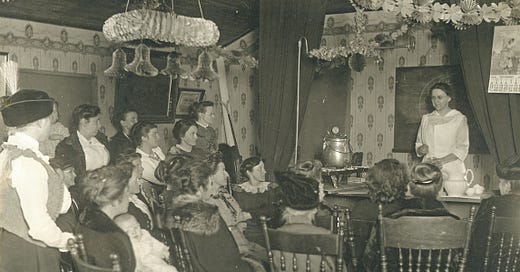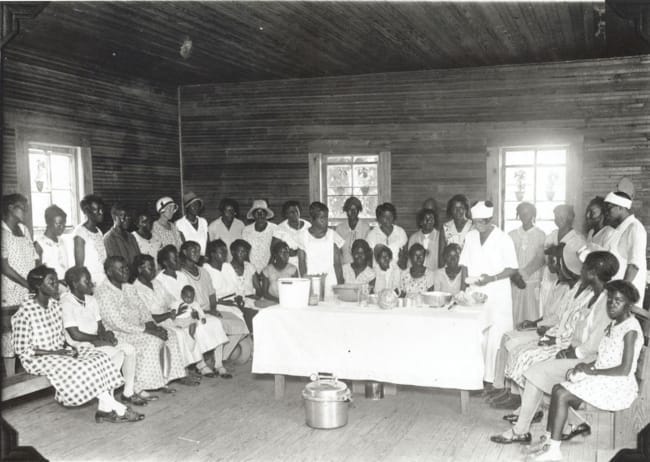(Image from Wikipedia)
Two summers ago this month, I was contacted by Morgan Bolling, Executive Editor of Creative Content for Cook’s Country and TV personality. A North Carolina native (woohoo to the Tarheel State!), Morgan was spearheading the initiative that was to become the America’s Test Kitchen-published book When Southern Women Cook, with “a mission to highlight the unique ways food has sustained all kinds of Southern women through history and continues to feed them today.”
In her initial outreach, Morgan asked if I might be interested in contributing content on home canning to the publication, specifically as it related to women in the southern US. She also mentioned that my imminently wise Texas-bred, NC-based food historian friend KC Hysmith was involved, offering her expertise. I was beyond honored to be tapped for the project, and jumped into researching the topic.
What I discovered floored me. Were you aware that free instruction and scientific information on how to can and preserve surplus produce was at one time brought directly into local communities, and even individual homes, in the early part of last century? By the government, no less? And by a cadre of all-female staff at that?!
I was not. But inspired by my findings I was! I’ll share my essay below. The way these “Home Demonstration Clubs” empowered women and positively shaped and changed communities proved powerful and enduring.
(Image from Arkansas Extension Service)
A Can-Do Attitude: The Female Agents Who Brought Canning Into Communities
(shared with permission from When Southern Women Cook: History, Lore, and 300 Recipes with Contributions from 70 Women Writers, 2024, America’s Test Kitchen)
By Ashley English
“For several decades in the early 20th century, the knowledge required to learn home canning practices was brought directly into American homes and communities by a nationwide cadre of women. The Victory Gardens that citizens were encouraged to grow during World War 1, so as to reduce the need for food rationing, resulted in a bounty of produce needing preservation.
At the time, however, home canning was not commonly employed, particularly those practices deemed “safe”, such as two-piece lid enclosures, and the need to pressure can low-acid foods. Enter the US Government. Through the creation of the Smith-Lever Act of 1914, officials at the United States Department of Agriculture (USDA) founded a national Cooperative Extension Service, offering outreach programs nationwide.
The stated intention of this initiative was to educate Americans, especially those living in rural settings, about innovations in agricultural practices and technology, as they related to home and farm life. This is how home demonstrations, also known as home demonstration clubs and homemaker clubs, came to be. These programs, which were racially segregated, proved to be quite popular. By World War II, home demonstration clubs had 55,185 total members in 2175 clubs, of which 12,952 members were African American in 587 home demonstration clubs (according to “Green ‘N’ Growing: The History of Home Demonstration and 4-H Youth Development in North Carolina”, a website of the Special Collections Research Center at the NCSU Libraries).
Federally employed and appointed agents, all of them women, worked with individual state agencies to spread “expert” information on home economics and “homemaker” skills, chief among them home canning. These skills were taught through community meetings, as well as in community member’s homes. A USDA booklet from 1951 declared the objective of the home demonstrator agent as such: “To give rural people, in a form in which they can use it at a time when they need it, information that will enable them to become better citizens in a democracy.”
Attendees of these programs not only learned new information on food preservation and more, they used their newly acquired skills to produce goods used to generate income and personal empowerment. As professor, historian, and author Marcie Cohen Ferris writes in The Edible South, "Producing and selling these goods not only connected rural women to social and economic networks that stretched far beyond their farms, but also shifted how they thought about themselves."
Furthermore, Ferris relays how "female extension agents strengthened their constituents' sense of self-worth by recognizing their contributions to the household economy.” Money garnered by women from the items they sold at female extension agent-organized “curb markets” especially by women of color, was used to "buy special treats for themselves and their families, and, not infrequently, to pay rents and mortgages and buy needed farm equipment."
Home demonstration clubs became beloved spaces where women could develop new skills while at the same time socialize and, later, as the clubs evolved, engage in community outreach, including offering services for the elderly and infirm in local communities, as well as hosting fundraising events for charities. By the 1960s, with more mechanized food production, the need for the clubs waned—along with government funding—but the skills and community stayed.”
(Top image from Oklahoma Historical Society, bottom image from University of Tennessee)
I can’t recall a time when home canning wasn’t a part of my life. I have the most vivid memories as a young girl of watching my maternal grandmother (“Nanny” to me) fill and then process pint jar after pint jar of bread & butter pickles, grape juice, and so much more. The foundation was laid for my own future passion of putting all manner of foods in jars.
Since that formative period, I’ve gone on to not just regularly put up a bevy of preserves for my own family, but to also teach others to do the same, both in person and in book form. Learning about the all-female Home Demonstration agents who transformed communities during the war years was so tremendously inspiring, I found myself yearning for a revival of the program, for which I’d gladly offer up my services. Who’s with me?!
Women, in community, are indeed profound agents of change.









Thanks for this. And gosh, I have been looking for folks who teach a hands-on canning class and they seem to be hard to find. (And hey I'm in the Candler area if you're ever going to do one soon!) There's so much information out there, for sure, on YouTube and your fabulous book. But there's nothing that beats the real hands-on, have somebody help you do it once, kind of teaching. Especially when words like botulism get passed around! But more than that, it is really fun to get together with people in your area and connect and socialize and maybe share resources and learn together. Kind of wish we could all get back to things like that.